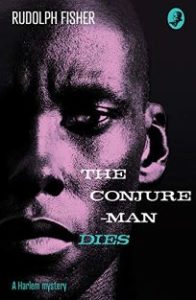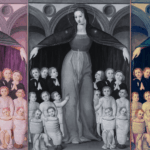This January, the Collins Crime Club issued a new edition of Rudolph Fisher’s classic crime novel The Conjure-man Dies, originally published in 1932 and considered to be the first detective novel by an African-American author, as well as being steeped in the literary culture of the Harlem Renaissance. The Collins Crime Club, a historic British imprint, was relaunched a few years ago with the intention of bringing lost and little-known classics back into print, focusing on Golden Age writers. We asked David Brawn, the publishing director for the Collins Crime Club, a few questions about the imprint, its history, and its latest reissue, The Conjure-man Dies.
CrimeReads: Bringing a book back into print is obviously a labor of love. Can you talk about the process of reissuing a book?
David Brawn: In the age of the ebook and print-on-demand, it’s perhaps hard to imagine a time when books went out of print. But books were printed in factories by the thousand, and it was not economical for publishers to keep them in stock for the sake of a few extra sales a year, so titles would disappear and once-popular authors could be forgotten within a generation. But regardless of when a book was first published, it is still a brand new book when you read it for the first time. Like many of our reissues, The Conjure-Man Dies was recommended to me, but there was no ebook—I had to track down a 50-year-old reprint—and when I read it, I thought it was really distinctive, clever, authentic, and at times unsettling in what it was saying about 1930’s America, and I just felt that I knew a lot of people who would also enjoy it.
CR: How did the relaunched Collins Crime Club come to be, and how it compares to its namesake?
DB: Detective fiction rose to prominence after the First World War—before then most mysteries were in the form of short stories, like those of Sherlock Holmes—and by the 1920s people from all walks of life were reading howdunits and locked-room mysteries. Many publishers capitalized on this popularity by launching dedicated imprints, and Collins’ Crime Club became one of the most successful, running for 65 years. But different types of book go in and out of fashion, of course—Westerns, war stories and Cold War thrillers, for example, have at different times been the most popular reads, and the Crime Club list was finally wound up in 1994. When it became clear that classic detective fiction was enjoying a renaissance—in no small part thanks to the efforts of Martin Edwards and the British Library in reprinting some old classics like J.J. Farjeon’s Mystery in White, which was originally a Crime Club book—we decided to relaunch the imprint as a vehicle for bringing back into print some genuine classics of the Golden Age, as well as the occasional new book, too. We launched it in 2015 with Martin’s The Golden Age of Murder, probably the definitive book about the genesis of British detective fiction, and have published more than 100 titles over the last five years.
CR: The Conjure-Man Dies has drawn more attention as a classic of the Harlem Renaissance than as a classic of detective fiction, but that’s changing now. Can you fill us in on the background of The Conjure-Man Dies, and its place in the history of crime fiction?
DB: It was when working with John Curran on his book The Hooded Gunman, the official history of the Crime Club, that I was struck by the fact that, at its height between the wars, there didn’t appear to be any black writers contributing to the Golden Age. Writing and publishing then was very much a white privilege, with few exceptions. So my delight at discovering Rudolph Fisher, and my dismay in finding that he died after writing only two novels, were profound. I was reading a lot of vintage detective fiction to fuel the new imprint, and was struck by how lively and witty this book was compared to many of its contemporaries. It must have felt very modern in 1932, and very up to date, with Fisher using his knowledge as a doctor to bring in some (for the time) cutting-edge forensics about blood and fingerprints. And there’s a clever murder that takes place in plain sight—so all the ingredients are there. I read that he was inspired by reading Agatha Christie—she really was the benchmark, and his story.
CR: Rudolph Fisher, The Conjure-Man Dies’ promising young author, died young. What was his life like, and his journey through publishing?
Rudolph Fisher was born in Washington D.C. in 1897, son of a Baptist pastor. He graduated with honors from Classical High School in Providence, Rhode Island, going on to Brown University and subsequently the illustrious Howard University Medical School, specializing in research into early radiology. Also a writer and musician, Fisher was an active participant in the Harlem Renaissance, the arts revolution that swept New York in the 1920s, and a supporter of Pan-Africanism and the broader struggle for black labor privilege and women’s empowerment.
Fisher was said to be one of the wittiest writers of his generation, winning acclaim for several short stories including ‘High Yaller’, which won the literary prize of the black magazine The Crisis. In 1927 Fisher opened his own practice as a radiographer in New York City, and in 1928 published The Walls of Jericho, a brilliant satirical novel about a black man moving into a white neighborhood. As a writer, Fisher was at his most masterful when illustrating the day-to-day reality of ordinary people’s lives, and though this comes across in The Conjure-Man Dies, it doesn’t overwhelm his clever story, which is why it would have been so interesting to see how he might have developed as a crime writer. But Dr Fisher died in 1934 at the age of 37, seemingly as a result of exposure to his own X-ray machines, and one can only speculate about what he would have achieved had he lived longer.
What are some other works you’re looking forward to bringing out over the next year?
We have a new book in April by the “Agathologist” Mark Aldridge, celebrating 100 years of Poirot—Agatha Christie’s Poirot: The Greatest Detective in the World, which has already been released in the UK to great acclaim among Christie fans. Also a brand new Sherlock Holmes novel, The Three Locks by Bonnie MacBird, who really seems to be carving a niche as a favourite among Sherlockians—this is her fourth, and the best yet. Apart from reissuing Fisher’s The Walls of Jericho in May, which isn’t a mystery book but does include some of the same characters as Conjure-Man, we also have The Chill Factor by Richard Falkirk, a Cold War murder mystery first published 50 years ago, set in Iceland when there was still an American naval base there, and a follow-up set in Israel during the Middle East conflict, The Twisted Wire—both are terrific reads. And in our Bodies from the Library series, there’s a fourth volume of uncollected and unpublished stories by the greats of the Golden Age, including John Dickson Carr and Edmund Crispin; plus The Wintringham Mystery, a full-length country house murder by Anthony Berkeley, the founder of the Detection Club (who also wrote as Francis Iles), which was published in such a small way that literally only about three copies form the 1920s are known to have survived. There’s a murder, a disappearing woman, a secret passage, a séance—perfect Christmas reading!
***
















